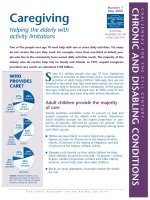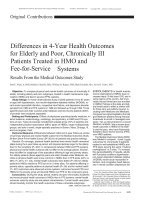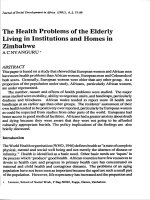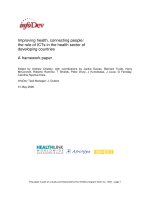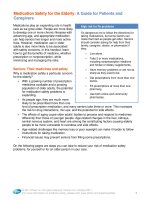Improving Health Outcomes for the Elderly: An Analytic Framework doc
Bạn đang xem bản rút gọn của tài liệu. Xem và tải ngay bản đầy đủ của tài liệu tại đây (339.82 KB, 14 trang )
441
23rd Bled eConference
eTrust:
Implications for the Individual, Enterprises and Society
June 20 - 23, 2010; Bled, Slovenia
Improving Health Outcomes for the Elderly
An Analytic Framework
Elaine Lawrence
University of Technology, Sydney, Australia
Christian Sax
University of Technology, Sydney, Australia
Karla Felix Navarro
University of Technology, Sydney, Australia
Abstract
The authors present an analytic framework for investigating interactive gaming
technologies and integrating a number of such technologies into a remote healthcare
monioring system (ReMoteCare) to help improve the quality of life of the elderly, the
chronically unwell and infirm whether they are living in their own homes or in aged
care facilities. The framework covers population characteristics of the cohort, the
interactive technologies as well as economic and environmental factors. It is
anticipated that a series of interactive exercises, developed in conjunction with a
Feldenkrais movement therapist who specializes in exercises for the elderly, will help to
improve the physical and mental health outcomes of this cohort.
Keywords: Interactive, games, elderly, chronically unwell, analytic, framework
1 Introduction
Remote monitoring of health conditions is an essential step for collecting evidence for
improving the physical and mental outcomes for the elderly, chronically unwell and
infirm as well as for policy development for governments . However, it is also vital to
encourage such people to do beneficial physical and mental exercises and support them
throughout the process in order to maintain good health outcomes. Current information
and communication technologies on assistive healthcare mainly focus on remote sensing
Elaine Lawrence, Christian Sax, Karla Felix Navarro
442
using the Internet and wireless sensor networks for collecting health condition data of
elderly people. Examples include the ReMoteCare system (Fischer et al, 2008),
(Lawrence et al, 2010) as well as the Personal Health Monitor developed at our
university (Leijdekkers et al, 2007). Very little effort has been made to support
collaborative planning, implementation procedures for physical training (such as
callisthenics and cardiovascular exercise), mental training such as described by
Chilukoti et al (2007) and assessment. Our proposed mobile interactive technology aims
to allow people to perform fitness programs while their physiological conditions are
sensed and functionally assessed remotely. We have used an Analytic Framework based
on work by Jimison et al (2008) to investigate the aged population cohort, to study the
econonomic and environmental facors and to help in assessing whether interactive
technologies are useful for the elderly, chronically unwell and the infirm.
The percentage of aged persons over 65 is increasing dramatically both in Australia and
worldwide and unfortunately, as people age, their mental and physical health
deteriorates and impacts negatively on their quality of life. This paper specifically
investigates ways in which Interactive technologies, such as the Nintendo Wii and
Project Natal could help to overcome functional decline, maintain independence and
preserve social connectivity and engagement among seniors (Jimison, 2008). Our
project should, in time, reveal (a) the potential impact of interactive computer
technologies on client and carer outcomes and satisfaction levels, (b) the potential
impact of clients’ abilities to adapt to the introduction of new technologies, and (c) the
potential benefits and obstacles to the application of interactive technologies in aged
care environments, both at client’s homes and at aged care facilities (Lawrence et al,
2010).
In Section 2 of the paper we describe the analytic framework and in Section 3, we
outline the population characteristics of the cohort. Section 4 describes briefly the
ReMoteCare System and sets out sample studies as well as the interactive technologies
we will introduce into ReMoteCare. Section 5 outlines economic and environmental
factors. Section 6 contains the discussion of the known issues that must be solved. The
conclusions are set out in Section 7
2 The Analytic Framework
The authors have modified the Analytic Framework used by Jimison et al (2008) in their
landmark study on Consumer Health Information Technologies used by the elderly,
chronically ill and underserved. Our modifications limited the technologies to
Interactive Game Techologies and the ReMoteCare system rather than dealing with the
full gamut of healthcare information technologies. Figure 1 below sets out the
Analytical Framework which is described in the following sections.
Improving Health Outcomes for the Elderly
443
Figure 1: Analytic Framework (based on Jimison et al, 2008)
3 Population Characteristics
In the study by Jimison et al (2008) factors such as age, gender, ethnicity, education,
language, chronic conditions, disability, income, literacy and numeracy, technical
expertise, health belief, preferences and health insurance status were also examined. In
this paper, we limit our disussion but the above factors will be studied when our trials
begin in September 2010. Our research shows that the percentage of aged persons over
65 is increasing dramatically both in Australia and worldwide and unfortunately, as
people age, their mental and physical health deteriorates and impacts negatively on their
quality of life. It has been posited interactive technologies could help to overcome
functional decline, maintain independence, preserve social connectivity and engagement
among seniors (Smits, 2008). The worldwide population of people over the age of 65 is
expected to more than double from 375 million in 1990 to 761 million by 2025
(Dishman, 2004). Within 40 years the number of people aged over 65 will almost triple,
from 2.8 million today to around 7.2 million in 2047, or from around 13 per cent of the
population today to over 25 per cent.
Inevitably, in a civilized society, community healthcare has to be extended to those in
their own homes. The cost of caring for the increasing numbers of aged persons in
private dwellings, nursing homes or hospitals will be a huge challenge for governments.
For those seniors who prefer to live independently in their own homes, constant
monitoring is essential to provide adequate care as there is an increased risk of falls,
strokes and other health problems which could prove life threatening or impact
negatively on their quality of life. In 2002, nearly 13,000 people aged 65 and older died
Elaine Lawrence, Christian Sax, Karla Felix Navarro
444
because of fall-related injuries (Gillespie et al, 2003). More than 60% of people who die
from falls are 75 and older (CDC 2009). Falls are common among community-dwelling
elderly people and can have a considerable impact on quality of life and healthcare costs
(Hendriks et al, 2005). Gururajan et al (2005) stated most healthcare information is both
time and life critical, so it must be captured and/or delivered whenever and wherever
needed. Compared to young people, seniors are much more likely to suffer chronic
diseases, heart attacks and dementia, therefore, more and more nursing services need to
be provided for them. Many countries, including Australia, are facing a shortage of
nurses (Felix Navarro et al, 2009).
The question of how to efficiently utilize human resources for aged care is attracting
more public concern. In modern society, physical exercise, which is one of the best
solutions to improve elderly people’s fitness and protect them from suffering heart
attack and chronic diseases, is not popular or indeed often not possible for many seniors.
As well as lack of physical exercise, the state of seniors’ mental health has very
significant impacts on maintaining their quality of life (Kang et al, 2004), (Lawrence et
al, 2010). According to researchers in Singapore, playing games could efficiently
enhance seniors’ health both physically and mentally (Cheok, 2005). On another level,
treating the elderly in ill health situations is hampered by the fact that symptoms and
signs may not be as clear as they are in younger patients. For example, research
statistics from the United States of America indicate that less than 50 percent of patients
over 80 years with myocardial infarction present with chest pain. In many elderly
casualties, acute appendicitis does not produce the typical symptoms and signs. Only 50
percent of elderly casualties with surgically proven appendicitis present with such a
diagnosis at the time (Merck.com, 2010), (Lawrence et al, 2010).
4 ReMoteCare Architecture and Interactive Technologies
We provide a brief overview of ReMoteCare in the section before elaborating on the
selected interactive technologies.
4.1 ReMoteCare
The architecture of the ReMoteCare health monitoring system comprises the wireless
sensor network (pulse oximeter and environmental sensor motes) connected via a
gateway mote to the local host PC (Fischer et al, 2008). The sensor network
communicates via the CodeBlue protocol (Malan et al, 2004) to the gateway mote
which redirects the data to the local host for a first data analysis by a serial or USB
connection, depending on the programming boards adopted (MIB510/MIB520). On the
monitoring PC, Laptop or PDA, the ReMoteCare Graphical User Interface (GUI)
(adapted from the CodeBlue software) shows the data gathered on the screen, the
network topology and the patients (with Motes) connected as seen in Figure 2.
The data are locally stored on log files and then sent by an SNMP-proxy connection to
the remote host. The general architecture is structured as follows. A gateway board
called Stargate is the central device. The ReMoteCare base mote is plugged into the
standard mote connector of the Stargate. This mote is responsible for transferring the
data from the WSN to the Stargate. On the Stargate the serial forwarder application
sends this data to the Ethernet port. It uses TCP port 9000 to allow other applications
Improving Health Outcomes for the Elderly
445
like ReMoteCare to connect to this port. The serial forwarder transmits the queries of
the ReMoteCare application to the base mote as well.
Figure 2: ReMoteCare screen showing video (Fischer et al, 2008)
Figure 3: ReMoteCare Architecture (Fischer et al, 2008)
A USB camera is also connected to the Stargate and runs via a Video4Linux driver. The
web streaming application camserv
1
continuously reads pictures from the camera and
publishes them on TCP port 9192. ReMoteCare has to establish two TCP connections to
the Stargate. One connection is to port 9000 to connect to the WSN and the other one is
on port 9192 to read the video stream. Figure 3 shows the block diagram of the
ReMoteCare architecture. Figure 4 shows a diagram of the ReMoteCare setup.
1
Elaine Lawrence, Christian Sax, Karla Felix Navarro
446
Figure 4: ReMoteCare Health Monitoring System (Fischer et al, 2008)
4.2 Sample Health Interactive Technologies
Gamberine et al (2008) state that videogames have proven to improve elderly people’s
cognitive abilities and take care of psychological problems accompanying illnesses and
social isolation. Jimison et al (2008) have provided in their paper an extensive overview
of web based and game based applications for therapy and rehabilitation of elderly
people and believe that interactive technologies represent a viable solution to meet the
various physiological and psychological needs of this population cohort. Selected
results of their work on consumer health information technologies are contained in
Table 1.
Study Activity Description Outcomes Issues
Crosbie, 2006
Qualitative
Study, N=20
Stroke Stroke rehabilitation, user moves
arms and hands in a virtual
environment and interacts with
familiar objects
VE allowed pts with
limited movement
to experience sense
of 'presence'
Virtual reality made
some of the healthy
users motion sick
Kressig, 2002
Cohort, N=34
Physical
activity
for
elderly
computer system for exercise
promotion (questionnaire with
tailored recommendations)
N.A. Most problems had to
do with survey issues,
not computer. 22%
questions were mouse
related.
Cleland, 2007
Qualitative
Study,
N=12
Asthma Electronic peak flow meter linked
to a mobile phone with an
interactive screen to record current
asthma symptoms transmitted to
and stored in a server
Fast, easy to use,
time saver. Staff
agreed that
technology was
easy to use and
wildly popular with
patients
Problematic cable
attachments and data
head, sensitivity of
piko meter, absence
of a good cell signal
Kim, 2005
Qualitative
Study,
N=42
Diabetes
mellitus
Access a website via their mobile
phone or Internet and input their
blood glucose levels every day;
patients were sent the optimal
recommendations by both the
mobile phone and the internet
Easy to use N.A.
Kosma, 2005
Qualitative
Physical
disability
Web-based physical activity
motivational with and without
discussion, weekly motivational
Rated easy to use –
4.5/5
Rated helpful – 3.4/5
Improving Health Outcomes for the Elderly
447
Study,
N=25
messages
Table 1: Sample Interactive Technologies Studies (Jimison et al, 2008)
4.3 Assistive Activities for Physical and Mental Health
As part of our framework investigation, we disovered that mental stimulation postpones
the onset of dementia and might actually reverse the process (BJHCIM, 2008). New
evidence from the Alzheimer's Society suggests that the progression of Alzheimer's can
be slowed by the use of computer-based puzzles. Chilukoti et al (2007) describe a
promising assistive technology system they developed to promote both physical
exercise and cognitive stimulation for patients suffering from Alzheimer’s disease and
other dementias. Their system combines a portable mini stationary bike with an
interactive visual multiple choice question game. The bike provides the physical
exercise component. The cognitive stimulation is provided by the game that targets
areas such as memory, judgment, problem solving, recollection and matching to help
impede dementia. Chilukoti et al (2007) included certain multi-sensory stimulants such
as fibre optic lights and selective colours to relax and control agitation of patients with
dementia. They believe their system provides a safe and fun way for patients with
dementia to complete physical and mental exercise. Figure 5 shows the Mini Stationary
Bike with its interactive screen.
Figure 5: Mini Stationary Bike and Interactive Screen (Chilukoti et al, 2007)
4.4 Selected Interactive Game Technologies for the Population
Cohort
In our research we found that Interactive Video games such as Dance, Dance
Revolution, Rock Band and Guitar Hero help people to become active by following the
rhythm and imitating the dance steps. Other areas for investigation included online Live
Video conferencing. Reports have shown a high acceptance of this mode of
communication. In the training area the elderly and/or caregivers could interact with the
exercise experts in real time and at a time of their choosing (Lawrence et al, 2010).
Some useful and easy to implement collaborative technologies include WebEX (Cisco
WebEX, 2010).
Elaine Lawrence, Christian Sax, Karla Felix Navarro
448
4.5 4.5 Wii for the Elderly
In this section we discuss the selected interactive game technology we intend to couple
with ReMoteCare. As a competitor of Microsoft’s Xbox 360 and Sony’s PlayStation 3,
Nintendo Wii (pronounced /ˈwiː/) is a home video game console with a wireless
controller, the Wii Remote, which can be used as a handheld pointing device and detect
movement in three dimensions (Nintendo, 2010). According to the information from
Wii’s homepage (Nintendo, 2010), there are over thousands of Wii games which can be
installed on the console. Seniors could play baseball games and golf games by using the
Wii Remote under a nurse’s instruction. These sports games could help seniors to
exercise their arms and waist. Besides the Wii Remote, there are several game
controllers available on the market, such as Dancing Carpet and Wii Fit. By using the
dancing carpet as the game controller, the elderly could dance on the carpet to exercise
their knees, calf and toe muscles. Nintendo balance board, which is called Wii Fit, is
another game controller for the feet. Seniors could use the Wii Fit to play Yoga and
other games to improve their balance and strengthen knees and ankles. A simple
Wiimote that resembles a TV remote with which most elderly people are familiar easily
controls the Wii. It enables the elderly to participate in games they enjoyed in their
earlier years such as golf and bowls and to keep their minds active (Lawrence et al,
2010). The Nintendo Wii is an ideal tool for the elderly because its controller can track
spatial movement, which allows game play with normal human movements (Nintendo,
2010).
Figure 6 shows a senior interacting with a Wii console and Wiimote whilst other elderly
persons watch the results (Sale, 2010). The incorporation of this highly interactive
technology into our existing systems will present many challenges but we believe that
the mental and physical training benefits for the patients will be enormous, not least
because of the fact that these devices should prove popular with the aged cohort we are
targeting as many of them will have previously played real games of golf and bowls.
Figure 6: Using a Wii to Improve the Health of the Elderly (Sales, 2010). A Wii bowling
“competition” at a JFCS senior center in Phoenix (Sales, 2010)
Australia's Minister for Ageing, whilst referring to information from the Policy and
Evaluation Branch of the Department of Health and Ageing, stated: We are now seeing
baby boomers begin to retire; they are changing ageing in forever. They are healthy,
Improving Health Outcomes for the Elderly
449
active and want to live at home as long as possible (Elliot, 2008). Besides the
contribution on the physical health, interactive games help seniors improve their mental
health as well. According to the research of (Gamberine et al, 2008), seniors may
release their mental stress and forget their loneliness and depression when they are
playing games (Gamberine et al, 2008). At the same time, interactive games could help
those lonely elderly make new friends when they are playing games.
“The Wii is suitable for care homes as it can be controlled and adapted to suit
users of varying abilities. People can play as individuals or in groups so there
is plenty of opportunity for everyone to join in socially.”
(Gamberine et al, 2008)
4.6 Project Natal for the Elderly
Our second targetted game is Project Natal. Microsoft announced their new product
Xbox 360 ‘Project Natal’, which can be operated without controller, in June 2009
(Stien, 2009). Figure 7 show a person interacting with Project Natal due for release in
2010. The main concept of this non-controller game console is that the user is the
controller. This is the next step in interactive gaming. Players can navigate through
menus by using hand gestures – such as swiping left or right. Its inbuilt camera and
microphone enables facial and voice recognition. Project Natal will recognize the
seniors’ faces and sign them in automatically. The advantages are endless as the senior
can simply do the movements and not bother about using any controller. Games can be
controlled by users’ gestures, actions and voice, which are captured by the sensors and
camera.
“See a ball? Kick it, hit it, trap it or catch it. If you know how to move your
hands shake your hips or speak you and your friends can jump into the fun –
the only experience needed is life experience” (Project Natal, 2010)
Elaine Lawrence, Christian Sax, Karla Felix Navarro
450
Figure 7: Project Natal Interaction without a controller (Rigby, 2010)
5 Economic and Environmental Factors
In our Analytic Framework we also investigated economic and environmental factors.
We have already mentioned the problem of the shortage of qualified healthcare nurses
and caregivers for the aged cohort under study. Another economic issue is the fact that
governments must spend a huge proportion of their health budget on this aged cohort.
“The cost of caring for aging U.S. residents by 2030 will add 25% to the
nation's overall health care costs unless those residents actively work to stay
healthy and preventive services are provided to help them” (Medical News
Today, 2007).
Preventative measures such as improving the physical and mental health of the elderly,
chronically unwell and infirm must form a vital part of government strategy to improve
economic healthcare outcomes.
Researchers in Australia (Clark et al, 2010) investigated the feasibility of using the
Wii's skiing and snowboarding attachment, the balance board, to help rehabilitate
people who have had a stroke. Physiotherapists measure the centre of pressure of a
person's foot to assist a stoke patient to relearn how to stand. The laboratory grade
"force platforms" needed to do that cost more than £11,000 - putting them out of the
reach of many physiotherapy clinics so Clark et al (2010) investigated the balance board
to ascertain its suitability for assessing balance in stroke patients. These researchers at
Melbourne University, Australia, took apart a Wii balance board and hacked into its
strain gauges and accelerometers to tap into their raw data. Clark et al (2010) verified
that the Wii Balance board data is clinically comparable to that of a force platform:
“We found the data to be excellent. I was shocked given the price: it was an
extremely impressive strain gauge set-up. The low price of the Wii kit is now
seeing it used to assess rehabilitation after stroke, traumatic brain injuries and
to examine standing balance in children who were born pre-term.”
Clark et al (2010)
6 Incorporating Interactive Games into ReMoteCare
We have discussed the aspects of the Analytic Framework as they relate to our aims.
Such interactive games satisfy two aspects of the criteria namely the senior interacts
directly with the technology and the computer processes the information in some way.
We believe, however, they fall short in providing the elderly person or carer with patient
specific information in return. This is why we must integrate them into the overall health
monitoring system – such as the ReMoteCare prototype (Lawrence et al, 2010).
We set out below the way in which we would incorporate the data from, for example, the
Wii game into our existing system. Whilst the senior is playing a game (for example
golf) his heart rate will be monitored and captured by our system. Should his heart rate
increase over a certain threshold the video will pop up in the display and an alarm
sounded on the system for the monitoring caregiver. Special user interfaces for the
elderly must support an easy-to-use user experience. As not all elderly persons have
Improving Health Outcomes for the Elderly
451
experience with computer systems and may not have used a mouse and keyboard in
their lives it is of critical importance to make interaction as intuitive as possible. We
consider both the Wii and Project Natal should satisfy the above need (Lawrence et al,
2010).
As every person will have his/her own training and exercise program, an account
management system will be required. Because of the users’ lack of computer knowledge
and/or possible physical and/or mental impairments the computer system must be
intelligent enough to recognize users automatically. We are planning on integrating face
recognition software in order to provide automatic account sign in so that users are not
to login, as they might forget their user name and/or password frequently. This face
recognition software already exists in Project Natal so it is appropriate for our system.
We are planning on using out of the box training and game solution initially in order to
obtain early feedback and to test the feasibility of the set up. Ultimately our goal is to
develop training routines and exercises that are tailored to the need of users. These
exercises will be designed to improve specific health issues of the elderly. We plan to
develop our exercises in conjunction with a Feldenkrais movement therapist who
specializes in exercises for the elderly. One game will concentrate on balancing
exercises to improve the elderly pers on’s sense of balance, strengthen leg muscles and
decrease the number of fall significantly (Lawrence et al, 2010).
Our ultimate goal is to move away from the out of the box games and develop our own
games and user interfaces optimized for elderly users. A conducted user acceptance test
on a pilot should prove if the elderly are willing to use such a system on a daily basis.
One of the greatest challenges we are facing will be on the usability of the system. This
system will be a success only if the elderly can handle it with ease and find joy and
pleasure from interacting with the games. From a technical perspective it is essential
that the game modules are totally integrated into the ReMoteCare or other health
monitoring systems. The monitoring module has to be aware that users are doing
physical exercises which means their vital signs will change accordingly, for instance,
the heart rate will increase. Thus the system will need the intelligence to adjust the vital
sign thresholds in order to avoid false alarms on our interfaces.
Research has shown that the effectiveness of these technology interventions depends on
ensuring that the systems provide a complete feedback loop (Gamberine, 2008) Modern
interactive technologies have the capacity to assist the elderly to improve their quality
of life by helping to keep their mental and motor systems active, as well as providing
elderly care centres with additional social spaces that could potentially benefit the
elderly persons' emotional wellbeing.
7 Conclusion
The analytic framework assisted us in investigating the characteristics of the aged
population cohort, the economic and environmental factors and the specific interactive
technologies we believe will work with the ReMoteCare system. The aim of our
enhanced ReMoteCare is to assist the aged, chronically unwell and infirm to attain
better physical and mental health outcomes so that they are more able to understand
their limitations and gain self knowledge about their health status. In turn they should be
able to understand treatment decisions and make shared decision with their caregivers
and doctors. Utlimately it is hoped the system will contribute to an improved quality of
Elaine Lawrence, Christian Sax, Karla Felix Navarro
452
life, reduced healthcare costs and health satisfaction (Lawrence et al, 2010). Physical
injuries such as falls happen more frequently as people age. The following figures from
the Centre for Disease Control and Prevention demonstrates the serious situation.
“In 2005, 15,800 people 65 and older died from injuries related to
unintentional falls; about 1.8 million people 65 and older were treated in
emergency departments for nonfatal injuries from falls, and more than 433,000
of these patients were hospitalized.“(CDC, 2009)
CDC also pointed out that falls are the most common cause of injury deaths among
older adults (CDC, 2009). In our proposal, we will apply some adapted sports games on
Wii consoles and Project Natal devices to integrate these interactive technologies into
our existing ReMoteCare system so we can monitor the effect on the elderly patients’
health outcomes. As well as physical health, good mental health is very important in
nursing care according to the researchers from Oakland University, senile dementia is
another significant mental disease affecting elderly citizens’ heath (Chilukoti, 2007).
Once we integrate the interactive games into ReMotecare this year hope the power of
games and fun exercises will help the elderly to stay healthier. It also has the potential
to save health systems significant amounts of money.
References
BJHCIM. (2008). Wii keeps elderly active in care homes, The British Journal of
Healthcare Computing & Information Management. 30.4.2010, from
CDC. (2009). Falls Among Older Adults: An Overview. 30.4.2010, from
Cheok, A. D., Lee, S., Kodagoda, S., Tat, K. E. & Thang, L. N. (2005). A social and
physical inter-generational computer game for the elderly and children: Age Invaders.
Wearable Computer, 2005 (pp. 202-203). Los Alamitos, CA, USA: IEEE
Computer Society.
Chilukoti, N., Early, K., Sandhu, S., Riley-Doucet, C. & Debnath, D. (2007). Assistive
Technology for Promoting Physical and Mental Exercise to Delay Progression of
Cognitive Degeneration in Patients with Dementia. Biomedical Circuits and
Systems Conference, 2007 (pp. 235-238). Los Alamitos, CA, USA: IEEE
Computer Society.
Cisco. (2010). Webex. 30.4.2010, from .
Clark R. A., Bryant A. L., Pua Y., McCrorz P., Bennell K., & Hunt M. (2010). Validity
and reliability of the Nintendo Wii Balance Board for assessment of standing
balance. Gait & posture. Volume 31(3), pp. 307-310. DOI:
10.1016/j.gaitpost.2009.11.012.
Improving Health Outcomes for the Elderly
453
Dishman, E. (2004). Inventing Wellness Systems for Aging in Place. Computer.
Volume 37(5), pp. 34-41. DOI: 10.1109/MC.2004.1297237
Elliot, J. (2008). Record number of Australians living to be more than 100 years of age
and new phenomenon of “super-centenarians“. 30.4.2010, from
/>je045.htm.
Fischer, M., Lim, Y.Y., Lawrence, E., Ganguli, L.K., & Kargl, F. (2008). ReMoteCare:
Health Monitoring with Streaming Video. 7
Th
International Conference on
mBusiness, 2008 (pp. 280-286). Los Alamitos, CA, USA: IEEE Computer
Society.
Gamberine, L., Alcanis, M., Barresi, G., Fabreget, M., Prontu, L & Seraglia, B. (2008).
Playing for a real Bonus: Videogames to Empower Elderly People. CyberTherapy
and Rehabilitation, 2008. Volume 1(1), pp.37-48. 7.5.2010, from
/>Volume-1-Issue-1-Spring-2008.
Gillespie, L. D., Gillespie, W. J., Robertson, M. C., Lamb, S. E., Cumming, R. G. &
Rowe, B. H. (2003). Interventions for preventing falls in elderly people. The
Cochrane Database of Systematic Reviews, 2003. DOI: 10.1002/14651858.
Gururajan, R., M. and Soar, J. (2005). Introducing Mobile Technology in Support of
Healthcare. Cutter IT Journal of Information Technology Management, 2005.
Volume 18(8), pp. 12-1.
Haastregtm, M.H., J., Evers, P., Crebolder, S. & van Eijk, J. (2005). Effectiveness and
cost-effectiveness of a multi-disciplanarity intervention program to prevent new
falls and functional decline among elderly persons at risk: design of a replicated
randomized control trial. BMC Public Health, 2005. Volume 5(6).
DOI:10.1186/1471-2458-5-6.
Jimison H., Gorman P., Woods S., Nygren P., Walker M., Norris S. & Hersh W. (2008).
Barriers and Drivers of Health Information Technology Use for the Elderly,
Chronically Ill, and Underserved. Evidence Report/Technology Assessment No.
175 (Prepared by the Oregon Evidence-based Practice Center under Contract No.
290-02-0024). AHRQ Publication No. 09-E004. Rockville, MD: Agency for
Healthcare Research and Quality. November 2008.
Kang, C., Park, E., Son, I., Kim, Y. & Ryu, K. (2004). Conceptual design for robotic
arm wrestling. Robotics, Automation and Mechatronics, 2004 (pp. 1072-1076).
Los Alamitos, CA, USA: IEEE Computer Society.
Lawrence, E., Sax, C., Felix Navarro, K. & Mu Qiao, (2010). Interactive Games to
Improve Quality of Life for the Elderly: Towards Integration into a WSN
Monitoring System. The International Conference on eHealth, Telemedicine and
Social Medicine, eTELEMED, 2010 (pp. 106-112). Los Alamitos, CA, USA:
IEEE Computer Society.
Leijdekker, P., Gay, V. & Lawrence, E. (2007). Smart Homecare System for Health
Tele-monitoring. International Conference on Digital Society, 2007 (pp.3-3). Los
Alamitos, CA, USA: IEEE Computer Society.
Elaine Lawrence, Christian Sax, Karla Felix Navarro
454
Medical News Today. (2007). Elderly Care Costs Rising, Require Prevention, Study
Says. 20.4.2010, from
Merck.com. (2010). The Merck Manual of Geriatrics, Emergency Medical Care.
2.5.2010, from
Navarro, K. F., Lawrence, E., & Lim, B. (2009). Medical MoteCare: A Distributed
Personal Healthcare Monitoring System. The International Conference on
eHealth, Telemedicine and Social Medicine, 2009 (pp. 25-30). Los Alamitos, CA,
USA: IEEE Computer Society.
Nintendo. (2010). Wii Home page. 2.5.2010, from
Project Natal. (2010). You Are the Controller. 2.5.2010, from />US/live/projectnatal/.
Rigby, B. (2010). Microsoft: Xbox 360's Natal in stores 2010. 2.5.2010 from,
/>2010/2416917/story.html.
Sayles, J. (2010). Never too old to say ‘Wee!’: Seniors stay active by using popular Wii
video game, Jewish News of Greater Phoenix. 2.5.2010, from
/>active-by-using-popular-wii-video-game.
Smits, S. (2008). Technology to improve the quality of life. 2.5.2010, from
Http://grips.proinno-Europe.eu/knowledge_base/dl/691/orig_doc_file/.
Stein, S. (2009). The future 360: Project Natal takes shot at Wii. 2.5.2010, from



